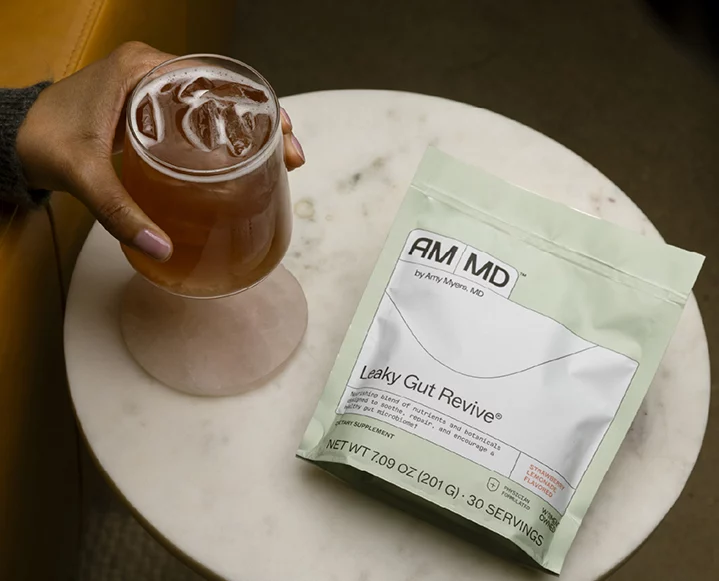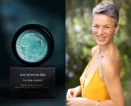Get used to hearing the word “longevity” more and more in the world of wellness. The conversations on living well longer – and without many of the diseases we associate with aging – is moving fast as the technology and medical research in these areas evolves at a rapid pace.
We’re exploring the new science behind autophagy with aging expert Naomi Whittel. In short, autophagy is a naturally occurring process in our bodies in which cells remove toxins, recycle parts and repair their own damage. Here is everything you need to know…
The Big Picture: The Origins of Autophagy
What is autophagy? Battling the visible and invisible signs of aging is very much a part of what led me on my search to better understand the science of autophagy. In the 1950s, Belgian scientist Christian de Duve was studying insulin when he accidentally discovered a process he called autophagy, from the Greek words for “self” (auto) and “eating” (phagy). It is the mechanism by which cells cannibalize some of their own parts in a continual cleanup process.
In the 1970s and ’80s, researchers began looking at the process of autophagy. It had not been studied extensively at the time, and nobody really knew its role or why it was important. The big breakthrough came in 1983, when researcher Yoshinori Ohsumi, while conducting experiments in yeast, discovered the genes that regulate autophagy. He found that without those genes, autophagy doesn’t work—and the cells can’t repair themselves. He won the Nobel Prize in 2016, as his work was considered fundamentally important to understanding how autophagy functions in cells.
The most fascinating part of the discovery of autophagy is that the process is given a boost if there is cellular stress. If cells lack nutrients, are deprived of energy, or are damaged in some way, a “stress response” mechanism is activated, which initiates autophagy. As a result, cell function actually improves when we’re under stress. In the absence of added stress, autophagy remains functioning at a moderate level, maintaining cell function. This is known as its maintenance mode.
As the research evolves, more and more scientists will be looking at the role of autophagy in aging—and how it is influenced by cellular stress, and that includes the Inevitable and Accelerated Agers.
On my quest to learn from the leading experts, I met William A. Dunn Jr., PhD, a professor of anatomy and cell biology at the University of Florida and one of the most respected authorities on autophagy, who has been studying the process for more than thirty years. He explained that as your cells get older, parts of the cells age and become nonfunctional. “Autophagy is a way of rejuvenating the cell,” he said. “It basically gets rid of the nonfunctional components of the cell.”
The thinking goes that when you activate autophagy, you reduce the chance of developing age-related problems and thus extend your life span. One study from the Journal of Clinical Investigation supports this theory by showing that things that extend longevity also show an increase in autophagy. That’s partly because, as another study from the journal Cell shows, one of the characteristics of aging is the accumulation of various forms of “molecular damage.” The study authors noted that one of the most promising areas in combating that damage is autophagy.
How does it combat that damage? It’s your cellular cleansing cleanup crew.
Autophagy 101:
Your Cellular Cleansing Cleanup Crew
In most aspects of our life, we have no self-cleaners. Sure, there’s the self-cleaning oven, and our computers can do it, too, with automatic virus scans and whatnot. But most other things require some time and attention to remove the grime, dirt, and waste that accumulate over time. Wouldn’t it be nice to have self-cleaning bathrooms? But think of what would happen if we didn’t maintain our “things” with regular cleaning. Our kitchens, cars, and desks would become toxic cesspools of dirt, and they would be sickening. That, in a way, is what can happen to our cells. If waste and toxins are not properly disposed of, our cell functions degrade and decline, resulting in everything from dull skin to lackluster energy to weight gain to age-related diseases.
This is exactly what autophagy, your cellular self-cleaner, addresses. Remember, it literally means “self-eating” because your cells eat away their own junk. The result? Cleaner, younger, healthier cells.
Let’s take a look at how it works more specifically: Our bodies are like little universes. But instead of stars, they’re made up of trillions of cells, all of which play a role in how we function and how we live. They’re made up of a variety of parts that influence those cellular functions. For example, we have the mitochondria, which generate energy for the cell. Cells also include proteins, which are essential for virtually all cellular functions: They give structure to cells, they carry out chemical reactions in the body, and they serve as messengers to communicate a variety of information across the body.
Though they’re microscopic units, each cell chugs and churns, producing power and products that make your body function the way it does. These cells are doing the work that makes us think, move, feel—everything. These cells give you the power to send texts, remember song lyrics, calculate mortgage payments, write life-changing memos, reason logically with toddlers (well, maybe our systems haven’t quite been able to master that yet!), and everything else you do throughout your days.
These cells are always working. Most of the time, they do great work, especially when they’re young. Everything is brand-new, all systems are working in harmony, and things keep plugging along without a hitch. The cells do their jobs well and efficiently, and the end result is a young, energized, healthy body.
That doesn’t mean each cellular system works perfectly all the time. Our normal cellular machinery gets damaged with use over time through those Inevitable and Accelerated Agers I explained earlier. Many people assume that wear and tear is a fact of life—that no matter what we do, our bodies are going to break down because of aging. Certainly, we can’t defy the natural arc of life and death, but we can indeed stall the effects of aging. Here’s why.
Your cells break down parts of themselves by sequestering them into vacuoles and digesting them. As a result, they produce waste, mainly dead organelles, damaged proteins, and oxidized particles, and that waste needs to be removed. But unless it’s properly disposed of, that cellular waste stays and builds up in the body, becoming toxic to our cells. That accumulation is a key factor in the rate of aging. The junk gets in the way and makes everything malfunction. It may sound like jargon from biology class, but the reality is that when the toxins damage the machinery of your cells, it contributes to the aging process—it causes your skin to look older, your body to slow, your energy to drop, and your hormones to go haywire. I don’t want that, and I know you don’t either.
That’s why autophagy is so important. It’s like a cellular garbage disposal, taking the dysfunctional parts and obliterating them so they don’t cause a mess anywhere else. When it’s working well, it’s a form of self-renewal, breaking down older structures so that new ones can be built in their place. The result is that the newer, more youthful structures allow our cells to function as if they’re, well, newer and more youthful!
You can imagine how that plays out in your everyday life. More youthful cells means softer and healthier skin, less fatigue, a faster metabolism—it means your universe of cells radiates youthfulness everywhere, from your organs to your brain to your muscles to your mental well-being.
I met with leading autophagy researcher Beth Levine, MD, director of the Center for Autophagy Research at the University of Texas Southwestern Medical Center. The expectation of her research is that it will lead to major discoveries in the treatment of aging, diseases like cancer, and infectious diseases. Her lab identified the first known gene responsible for autophagy in mammals. She says the trash-removal function is what keeps us healthy.
In a study in the journal Diabetes & Metabolism, the authors described autophagy as a “survival strategy,” which makes a lot of sense: From a cellular perspective, we’re just trying to survive. From a lifestyle perspective, the strategy to survive becomes a strategy to thrive—because younger cells mean a younger self.
The Autophagy On/Off Switch
So why doesn’t autophagy work well all the time? Autophagy is like everything else in your body: As you age, it naturally declines and becomes less efficient—meaning that you’re now saddled with a twofold problem. Your cells accumulate a lot of junk and your body can’t keep up with clearing away that junk due to your constant exposure to Accelerated Agers (see page 16). More waste equals more damage. More damage, with no way to fix it, equals increased aging.
All that cellular waste is linked to not only things like skin damage, but also cancer and neurodegenerative diseases like Parkinson’s. This decline in autophagy is considered a vital consequence of aging. It’s not just the deterioration of our cells that’s so bad; it’s also the decline in our ability to fix it.
There’s another important point to consider: Autophagy can’t always be on high. Cells can’t be constantly cleaning up waste; they also have to be doing the work that produces the waste. Think about it like this: Picture your kitchen. Let’s say you make dinner and clean up after the meal. This multistep process includes preparing the meal and getting rid of the waste after you eat.
So autophagy is a series of steps that keep your cellular kitchen free of clutter, and you need them all to work. If there’s a pileup at the sink or the kitchen trash or the outside trash can, there will be clutter somewhere.
But the catch is that you can’t always be in cleaning mode; you have to have something to clean up. You need the kitchen to prepare your food, just in the way that your cells need to be doing other jobs. So when a kitchen is truly humming, it’s a balance between making food and cleaning waste. Ideally, that’s the same process for your cells—providing energy to your whole body and then cleaning up the waste products. This is the idea behind autophagy being turned on and off. When the kitchen is being cleaned, in response to that stressor, autophagy is working at its highest level—remember the stress-response mode. And when you’re making and eating dinner, autophagy is at its lowest level—the maintenance mode. Think of it this way—it’s like electricity. If you plug in a lamp, the electricity is always flowing whether the switch is turned on or off, but more electricity is needed to power it on.
There are two ways to turn autophagy on and off to defy aging: First, naturally induce some stress on your body; and second, integrate autophagy-activating nutrients. Since most of us, as a result of those Inevitable and Accelerated Agers, have low levels of autophagy, I’ll show you how to boost your cellular cleansing cleanup crew’s function so you look and feel younger.
Advanced Autophagy: The Missing Link in Antiaging
Autophagy is one of the most important breakthroughs in the science of aging. While scientists have known about this process since the 1950s, only in the past decade have we been able to see the effects of activating autophagy to improve our cellular health. Research published in the Journal of Clinical and Experimental Pathology explains that “autophagy promotes cell maintenance by removing accumulated toxic material and by using recycled components as an alternative nutrient resource. This suggests that autophagy favors longevity because an organism can recover more quickly from stress-induced cellular damage.” As you can imagine, when the cells can effectively clean up the damage that they produce, that means they will function better.
In practical terms, that means all of your body’s cells will work better.
Autophagy enhances metabolic efficiency. From the deepest cellular level, autophagy can be activated to help improve the work of the mitochondria—the cell’s power plant. This makes cells work more efficiently. By doing so, autophagy helps cells become more resilient.
Autophagy prevents neurodegenerative disorders. Many neurodegenerative disorders are the result of damaged proteins that form in and around neurons. Autophagy protects us by getting rid of these proteins. In Huntington’s disease, Parkinson’s, and Alzheimer’s, autophagy cleans up specific proteins associated with those diseases.
Autophagy helps fight against infectious diseases. It does this by removing toxins that create infection, as well as by helping to improve how your body’s immune system responds to infections. Intracellular bacteria and viruses can be removed by autophagy.
Autophagy improves muscle performance. When exercising, we place a stress on our cells, energy goes up, and parts get worn out faster. Because of this, autophagy helps remove some of the damage and keep our energy needs in check.
Autophagy aids in the prevention of cancer growth. Autophagy suppresses systems and processes that can be related to the development of cancer, such as chronic inflammation and damaged DNA. Mice altered to have inefficient autophagy were found to have higher cancer rates.
However, cancer cells can hijack the process of autophagy and use it to their advantage to become chemo resistant. In later stages of cancer, as tumors begin to take over cells, autophagy is induced due to the stress of nutrient deprivation and energy depletion. This is why it is important to understand that autophagy should be turned on and off. Further research is needed since currently there is no way to measure the level of autophagy in humans when it comes to this area.
What science can tell us today is that autophagy works to make your body work better. By cleaning up cellular junk, you will clear the way for cells to rebuild themselves with new parts. Sort of like that biological upgrade—giving an older car a newer engine, so that it not only keeps running, it “corners like it’s on rails” (that’s a good thing, for those of you who haven’t seen the movie Pretty Woman!).
How to Activate Autophagy
In today’s world, we tend to look at things as black or white—no gray. Things are either good or bad. But when you really think about it, life is full of examples that are both good and bad at the same time—even things that have positive effects can have negative ones. Take the smartphone. It has unbelievable powers, and the technology has made our lives so much easier, but some would also argue that it has eroded social skills and created many more burdens on families as well. Or how about the sun? It’s unquestionably good because of its life-giving properties, but too much of it can kill us. What about fire? It provides warmth, it kills germs, and it can be essential for survival. But when left uncontrolled, fire can wreak havoc.
This “gray area” is essential to understanding what is autophagy and how is activated via cellular stress. Remember, autophagy is turned on when your body is in stress response mode. Stressing your cells is the natural way to turn on autophagy. You can do this through intermittent fasting and protein cycling to create nutrient deprivation in your cells. You can also create cellular stress in the body through exercise. I will show you novel ways to manufacture or hack your autophagy activation in part two. By taking polyphenol-rich supplements and using unique nutritional ingredients, you can control your autophagy. And that means you can influence the way you age.
New decade, who dis? Hitting reset is as easy as add to cart. Pressed Juicery takes the guesswork out of getting that 2020 reboot going with their half and full day juice fasts. Delivered to your door in a cute neoprene cooler, resolutions have never been easier!
This piece is excerpted from GLOW15 © 2018 by Naomi Whittel. Reproduced by permission of Houghton Mifflin Harcourt. All rights reserved.
The Chalkboard Mag and its materials are not intended to treat, diagnose, cure or prevent any disease. All material on The Chalkboard Mag is provided for educational purposes only. Always seek the advice of your physician or another qualified healthcare provider for any questions you have regarding a medical condition, and before undertaking any diet, exercise or other health related program.











